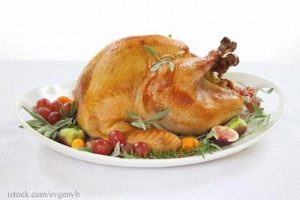The USDA is offering advice on the countdown to Thanksgiving Day. The key to a safe holiday is to plan ahead and make sure you follow all food safety rules.
 If you purchased a frozen turkey, it should be thawing in the fridge. For most sizes of frozen bird, it’s too late to thaw now in the fridge. You can thaw the bird in cold water, but that takes hours, and the water should be changed every 30 minutes to make sure it stays cold. Do not thaw a large turkey in the microwave; if you do thaw a smaller turkey there, it must be cooked immediately.
If you purchased a frozen turkey, it should be thawing in the fridge. For most sizes of frozen bird, it’s too late to thaw now in the fridge. You can thaw the bird in cold water, but that takes hours, and the water should be changed every 30 minutes to make sure it stays cold. Do not thaw a large turkey in the microwave; if you do thaw a smaller turkey there, it must be cooked immediately.
You can cook your turkey from the frozen state safely and easily. A fresh turkey should only be purchased one to two days before cooking. Today is a great day to buy your bird.
And remember never buy a pre stuffed fresh turkey, since it is a breeding ground for bacteria. Even if the stuffing gets hot enough to kill the bacteria, some of those pathogens produce toxins not destroyed by heat that can make you sick.
Make sure you use a reliable cooking chart for the timing of your bird, and always use an accurate meat thermometer to make sure the bird and stuffing are heated to at least 165°F for food safety. Even if your turkey has a “pop up” thermometer, always check the temperature with a meat thermometer.
The oven temperature should never be less than 325°F. An unstuffed turkey of about 12 pounds will take about 3 hours to cook at 325°F, while a stuffed turkey of that size will take 3-1/2 to 4 hours to thoroughly cook.
The day before Thanksgiving, make sure all of your ingredients are in the house. Also check all of the equipment and serving dishes you need. You can prepare some foods ahead of time. Combine the wet and dry stuffing ingredients and refrigerate them separately. Make salads and some of the vegetable dishes now; refrigerate them as soon as they are made.
On Thanksgiving Day, stuff the turkey loosely. Make sure that the stuffing is not dry, because the oven’s heat will kill bacteria more rapidly in a moist environment. Always put the turkey in the oven the minute it is stuffed.
When checking the temperature of the bird and stuffing, put the thermometer into the innermost part of the thigh and wing and the thickest part of the breast. Even if the meat is pink, it is safe to eat as soon as all parts reach at least 165°F. Make sure that the probe of the thermometer is not touching bone.
Let the turkey stand, covered, for 20 minutes after it comes out of the oven before carving. Take all of the stuffing out of the turkey then and put it in a serving dish.
Leftover safety is the final key to a safe Thanksgiving. The turkey should be cut into small pieces. Refrigerate the turkey and stuffing separately in shallow containers within 2 hours of cooking (not eating). Use leftover foods within three to four days or freeze them. And always reheat leftovers to 165°F as measured with a reliable food thermometer. Happy Thanksgiving!




